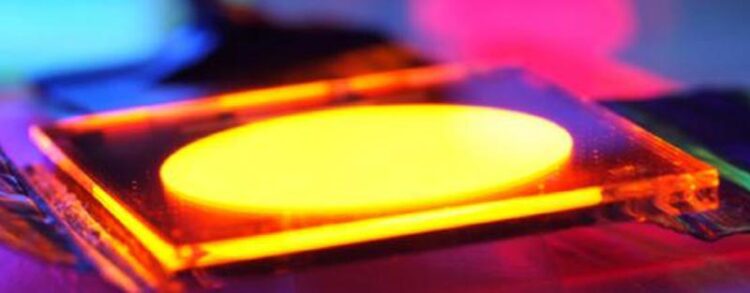Lighting up the future

Organic light-emitting diode
Credit: Professor Ifor Samuel
New multidisciplinary research from the University of St Andrews could lead to more efficient televisions, computer screens and lighting.
Researchers at the Organic Semiconductor Centre in the School of Physics and Astronomy, and the School of Chemistry have proposed a new approach to designing efficient light-emitting materials in a paper published this week in Nature (27 March).
Light-emitting materials are used in organic light-emitting diodes (OLEDs) that are now found in the majority of mobile phone displays and smartwatches, and some televisions and automotive lighting.
The latest generation of emitter materials under development produce OLEDs that have high efficiency at low brightness, but suffer reduced efficiency as the brightness is increased to the levels required for lighting and outdoor applications. This problem is known as ‘efficiency roll-off’.
Researchers have identified the combination of features of materials required to overcome this problem. Guidelines developed by the team of researchers, led by Professor Ifor Samuel and Professor Eli Zysman-Colman, will help OLED researchers develop materials that maintain high efficiency at high brightness, enabling the latest materials to be used for applications in displays, lighting and medicine.
Commenting on the research, Professor Zysman-Colman explained that the findings “provide clearer insight into the link between the properties of the emitter material and the performance of the OLED.”
Professor Samuel said, “Our new approach to this problem will help to develop bright, efficient and colourful OLEDs that use less power.”
Notes for Editors
The paper, ‘A Figure of Merit for Efficiency Roll-off in TADF-based Organic LEDs, is published in the journal Nature and is available online: https://www.nature.com/articles/s41586-024-07149-x
Please include the paper’s DOI 10.1038/s41586-024-07149-x in all online stories and social media posts, and credit Nature as the source.
The full listing of authors and their affiliations for this paper is as follows:
• Ifor Samuel: University of St Andrews
• Stefan Diesing: University of St Andrews
• Le Zhang: University of St Andrews
• Eli Zysman-Colman: University of St Andrews
Professor Samuel is available for interview; please contact the Communications Office in the first instance.
Journal: Nature
DOI: 10.1038/s41586-024-07149-x
Article Title: ‘A Figure of Merit for Efficiency Roll-off in TADF-based Organic LEDs
Article Publication Date: 27-Mar-2024
Media Contact
Christine Tudhope
University of St. Andrews
proffice@st-andrews.ac.uk
Office: 01-334-462530
Original Source
All latest news from the category: Interdisciplinary Research
News and developments from the field of interdisciplinary research.
Among other topics, you can find stimulating reports and articles related to microsystems, emotions research, futures research and stratospheric research.
Newest articles

Innovative 3D printed scaffolds offer new hope for bone healing
Researchers at the Institute for Bioengineering of Catalonia have developed novel 3D printed PLA-CaP scaffolds that promote blood vessel formation, ensuring better healing and regeneration of bone tissue. Bone is…

The surprising role of gut infection in Alzheimer’s disease
ASU- and Banner Alzheimer’s Institute-led study implicates link between a common virus and the disease, which travels from the gut to the brain and may be a target for antiviral…

Molecular gardening: New enzymes discovered for protein modification pruning
How deubiquitinases USP53 and USP54 cleave long polyubiquitin chains and how the former is linked to liver disease in children. Deubiquitinases (DUBs) are enzymes used by cells to trim protein…



